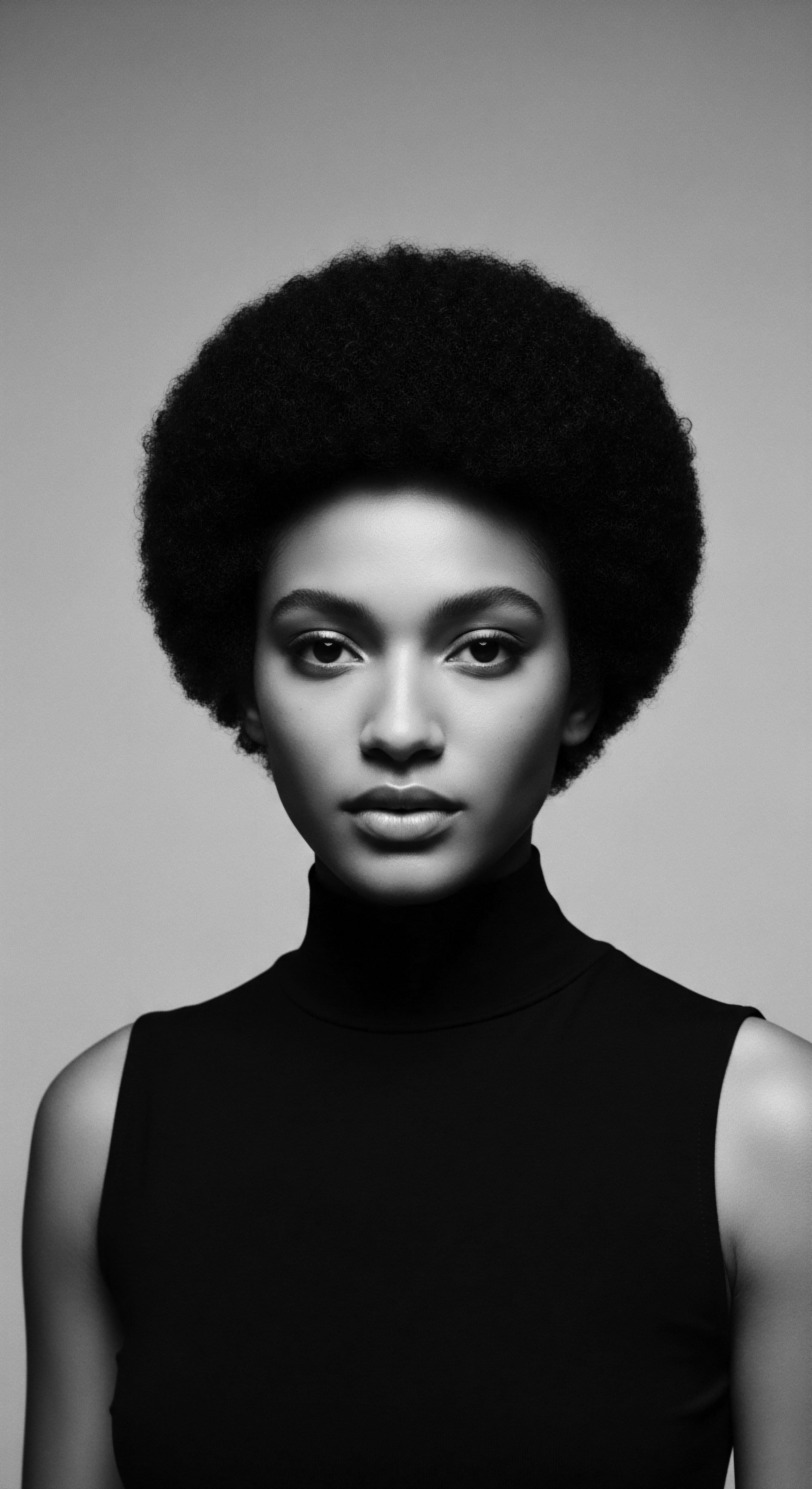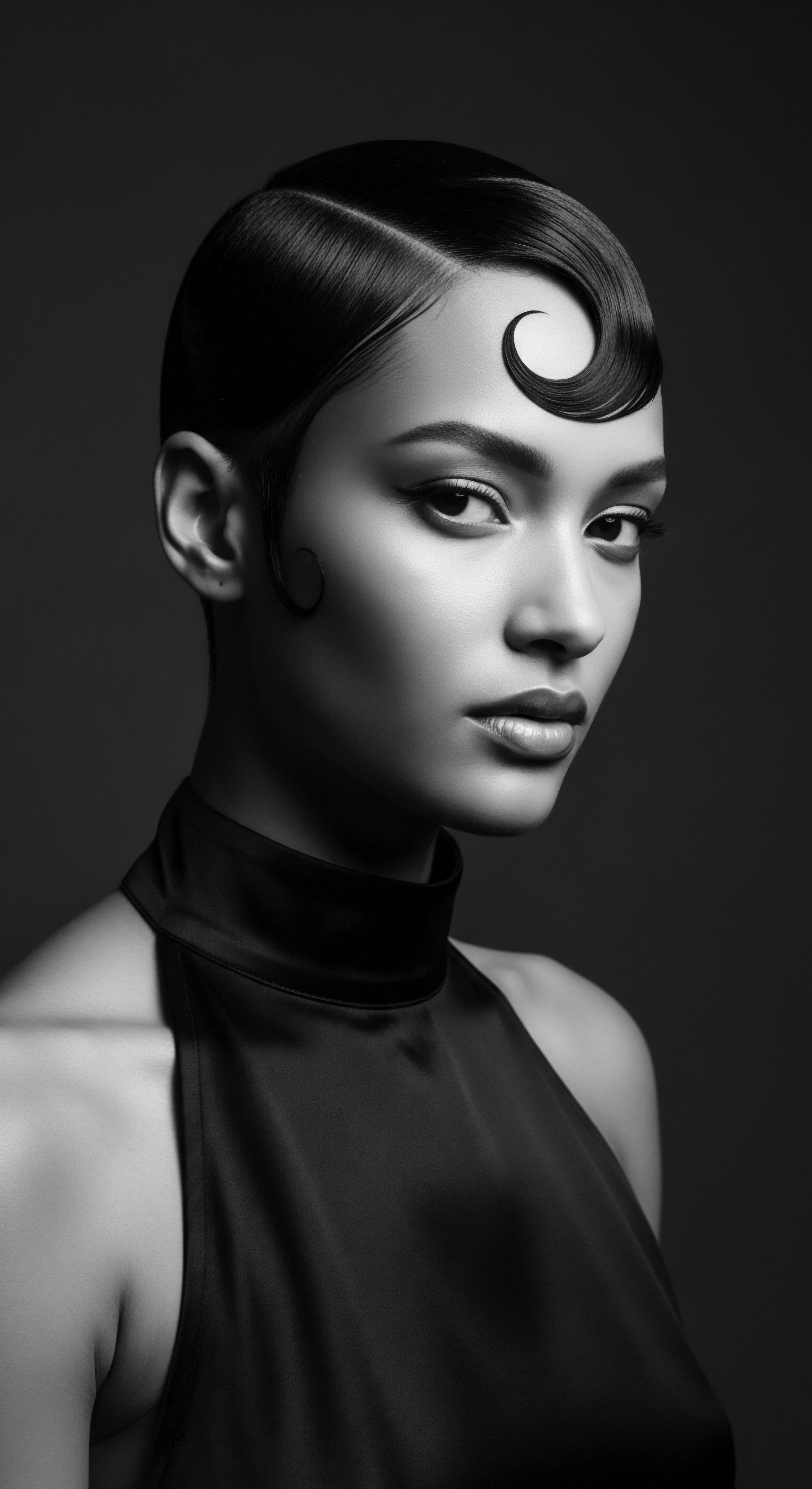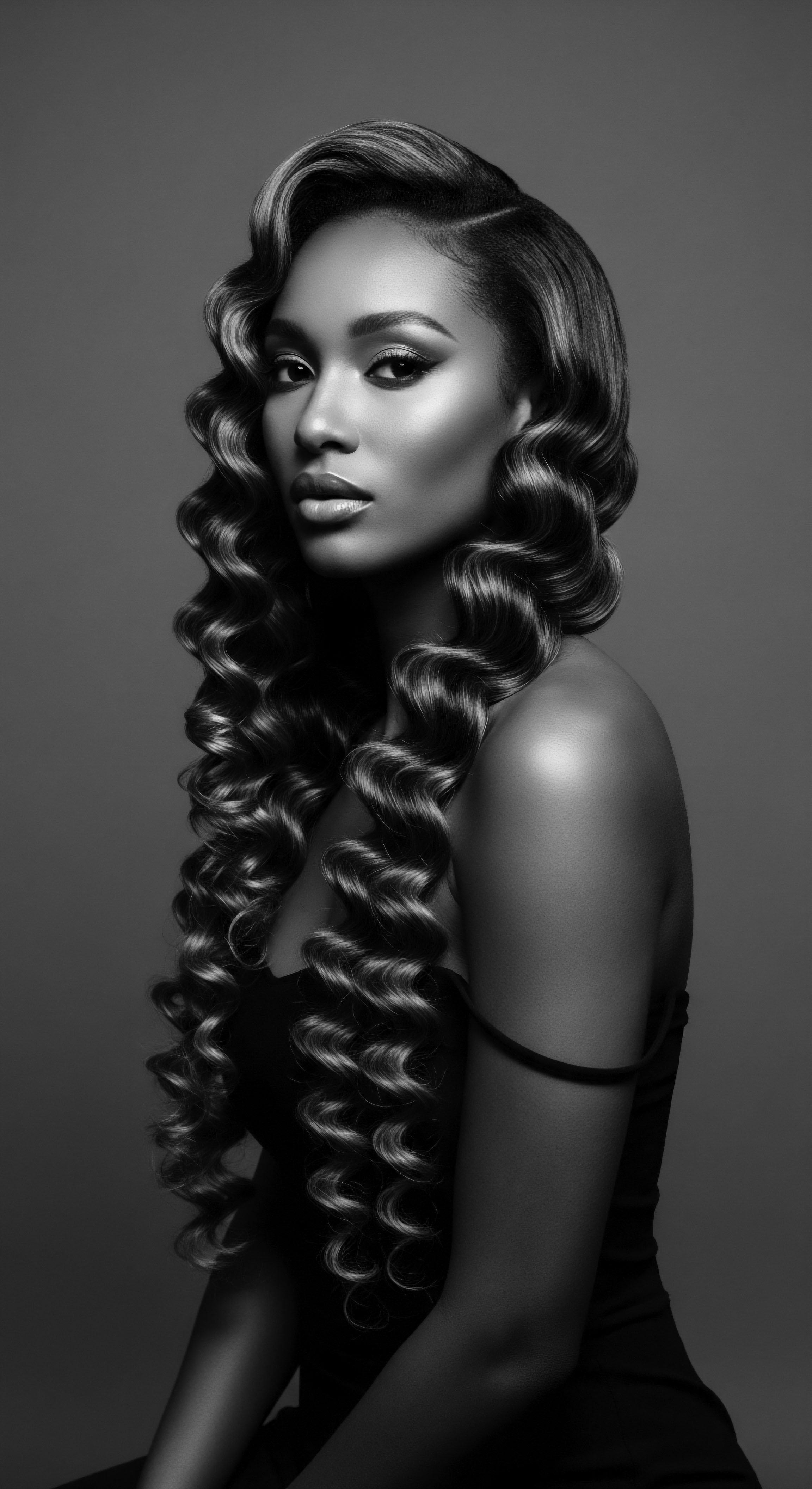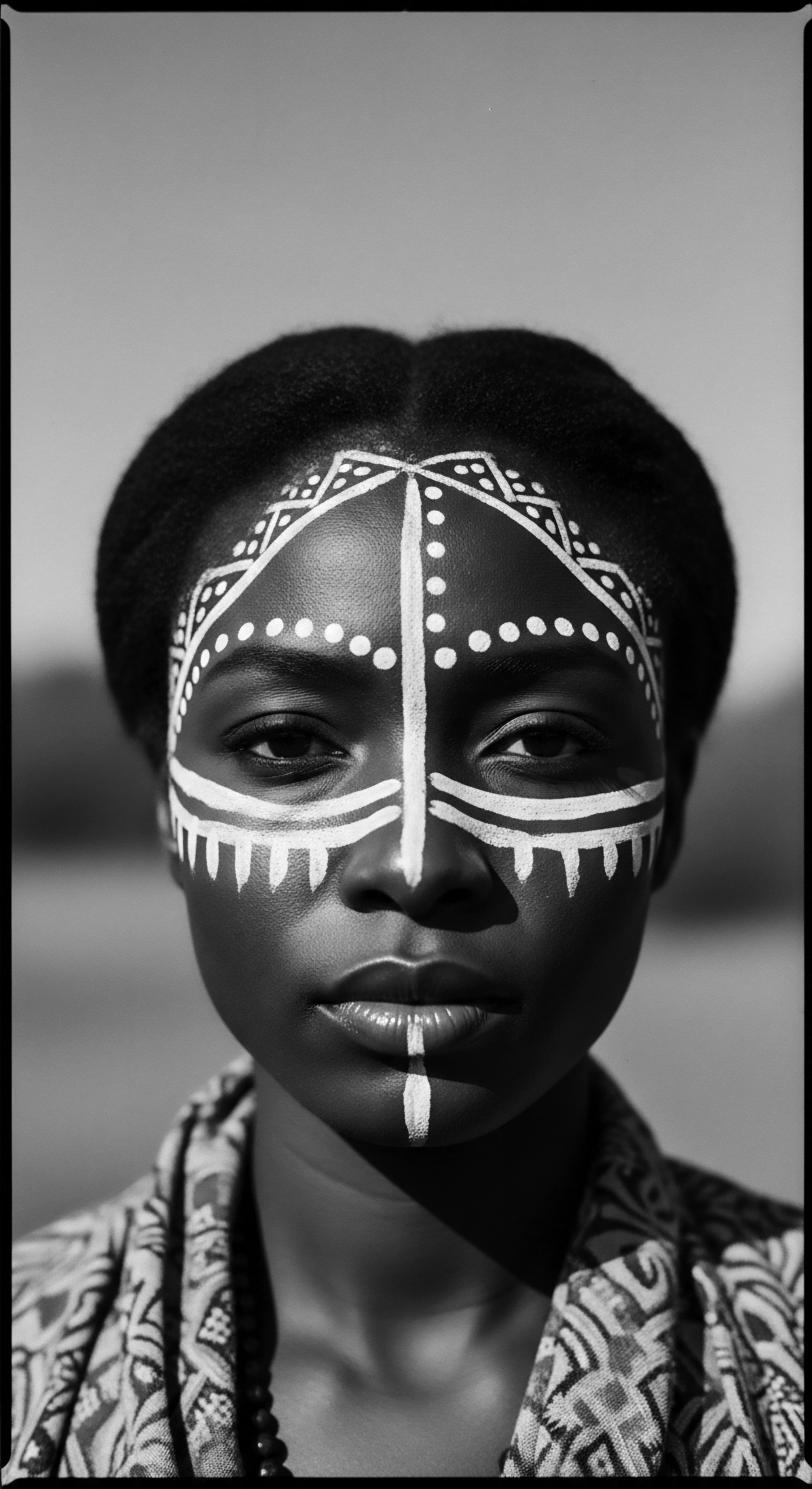
Roots
There is a profound connection we share with the strands that crown our heads, a silent language passed across generations, speaking of resilience and spirit. For those with textured hair, this connection is more than personal; it represents a deep ancestral memory, an echo from the source where practicality intertwined with spiritual meaning. To explore the historical roots of protective textured hairstyles is to journey into the heart of heritage, where each twist, coil, and braid tells a story of survival, identity, and enduring wisdom.
The practice of shaping and tending to textured hair reaches back millennia, predating written records in many civilizations. It speaks of a foundational understanding of hair biology, long before the advent of modern scientific inquiry. Our ancestors possessed an intuitive knowledge of what their hair needed to thrive, recognizing that protective styles served as vital guardians against the elements, mechanical stress, and daily wear. These styles were not born of caprice; they were born of necessity and a reverence for the crown.

Ancestral Hair Anatomy And The Art Of Preservation
To understand the need for protective styles is to understand the very nature of textured hair. Unlike straight hair, which hangs smoothly, coiled and coily hair, characteristic of many Black and mixed-race ancestries, possesses a unique elliptical cross-section and a varied growth pattern. This structure, while granting magnificent volume and shape, also renders it more susceptible to dryness and breakage.
The natural curves and bends within each strand mean that natural oils, produced by the scalp, struggle to travel the full length, leaving ends vulnerable. Moreover, the points where the hair bends are inherently weaker, making them prone to fracture from daily manipulation or environmental exposure.
Ancestral practitioners, through centuries of observation, understood these inherent vulnerabilities. They recognized that leaving the hair unbound and untended in harsh climates, or during rigorous physical activity, led to damage. Thus, protective styles arose as a direct response to these biological realities.
They served to tuck away delicate ends, minimize friction, and create a micro-environment that preserved moisture and strength. This was hair science in its earliest, most intuitive form.
Protective styles represent an ancient, deeply practical response to textured hair’s unique biological needs.

Early Interpretations Of Hair Systems
The earliest known depictions of braids, including what we now call cornrows, trace back to at least 3500 BCE in rock paintings discovered in the Sahara Desert. Other historical evidence indicates the widespread adoption of braided styles in ancient Africa, including Egypt and Nubia, around 3000 BCE. These ancient civilizations viewed hair with immense social and spiritual gravity.
Hairstyles were complex visual cues, a living record of an individual’s place within their community. They communicated a wealth of information at a glance ❉ a person’s age, their marital status, wealth, social standing, tribal affiliation, and even religious beliefs.
The terminology used to describe textured hair and its styles also carries ancestral weight. While modern classification systems attempt to categorize curl patterns, traditional societies often spoke of hair in terms of its social meaning and its role in communal life. For instance, the Yoruba people of Nigeria used the term ‘Irun Didi’ to describe a general style of braided hair, a living echo of practices that predate colonial imposition. These terms were not merely labels; they were descriptors infused with cultural context and a profound understanding of hair as a marker of identity.
The care of hair was often a communal activity, a social art that reinforced bonds between family and friends, particularly among women. Hours spent braiding fostered storytelling, the sharing of wisdom, and the strengthening of intergenerational connections.

Ritual
The journey of protective textured hair styling moves from elemental understanding to a vibrant ritual, a living art form passed through hands and hearts. The techniques and tools employed across diverse African communities and within the diaspora speak to an ongoing dialogue between human ingenuity and the natural world. These rituals, far from being superficial acts of beautification, embodied a profound connection to self, community, and ancestral lineage.

Ancestral Roots Of Protective Styling
Protective styling in ancient Africa went far beyond simply ‘putting up’ hair. It involved a diverse array of techniques, each with a history rooted in the specific needs and cultural expressions of various groups. Braids, twists, and locs were not merely functional; they were artistic expressions, symbolic statements, and practical solutions all at once.
For example, cornrows, often called ‘canerows’ in the Caribbean due to their association with sugarcane fields, were a central practice. Their designs could be straight, geometric, or curvilinear, each pattern carrying a unique significance.
Traditional African societies also utilized styles such as Bantu knots, which originated among various Bantu-speaking ethnic groups in Central and Southern Africa. These coiled formations, sometimes unraveled for a wavy pattern, served as an emblem of beauty and cultural heritage. Headwraps, too, played a protective role, shielding hair from harsh sun, dust, and wind. Beyond their practical utility, headwraps often conveyed social status, marital standing, and religious devotion, morphing into symbols of resistance during periods of oppression in the diaspora.
The shaved head was the first step the Europeans took to erase the slaves’ culture and alter the relationship between the African and his or her hair. stripped them of a lifeline to their home and a connection to their people. Their language was taken away and they were unable to identify with others from their tribe.
The transatlantic slave trade marked a painful yet profound shift in the history of protective styles. Stripped of their languages and tribal affiliations, enslaved Africans clung to hair practices as one of the few remaining ties to their heritage. In a devastating act of dehumanization, captors often shaved the heads of enslaved individuals upon arrival, seeking to sever cultural identity. Yet, resilience emerged from this trauma.
Protective styles, particularly cornrows, transformed into clandestine tools of survival and communication. Enslaved people would braid patterns resembling escape routes, or conceal seeds and small tools within their tightly woven styles, using their hair as a medium of rebellion and hope. These styles became a discreet way to transfer information and a powerful act of resistance against efforts to erase their culture.

Traditional Care And The Tools Of Heritage
The efficacy of these styles was supported by traditional care practices and the ingenious tools developed over centuries. Ancient African hair care emphasized the use of natural, locally sourced ingredients. These included natural oils like shea butter , coconut oil , and argan oil , prized for their moisturizing and protecting properties.
Herbs like hibiscus , amla , and neem were also incorporated for their restorative qualities. These botanicals were not just applied; they were often infused into oils or prepared in elaborate rituals, reflecting a holistic approach to wellbeing where hair health mirrored spiritual and communal harmony.
The tools for hair care were equally thoughtful. Early combs, crafted from wood, bone, or ivory, were essential for detangling and maintaining healthy hair. These implements, often finely toothed, were used not only to manage hair but also to distribute nourishing oils and stimulate the scalp. The act of tending to hair with these tools was often a shared moment, a time for intergenerational learning and the reinforcement of social bonds.
| Historical Era Ancient Africa (3500 BCE onward) |
| Primary Protective Style Motive Protection from elements, status display, communal identity |
| Cultural or Social Context Signified age, marital status, wealth, tribal affiliation, religious beliefs. Braiding as a social art. |
| Historical Era Transatlantic Slave Trade (16th-19th centuries) |
| Primary Protective Style Motive Survival, clandestine communication, minimal maintenance |
| Cultural or Social Context Secret maps, hidden seeds for escape, practical management under harsh labor. |
| Historical Era Post-Emancipation to Mid-20th Century |
| Primary Protective Style Motive Survival, conformity to Eurocentric beauty standards (often under duress) |
| Cultural or Social Context Hot combs and relaxers became widespread to achieve straight styles for perceived social and economic advancement, yet protective styles persisted out of necessity for some. |
| Historical Era Mid-20th Century (Civil Rights Era) |
| Primary Protective Style Motive Reclamation of identity, political statement |
| Cultural or Social Context Afros, then braids and locs, symbolized Black pride and resistance against Eurocentric beauty norms. |
| Historical Era Contemporary Era (2000s onward) |
| Primary Protective Style Motive Hair health, self-expression, cultural heritage celebration |
| Cultural or Social Context Resurgence of natural hair movement, embracing diverse textures, and styles for length retention and personal identity. |
| Historical Era This table illustrates the shifting yet enduring reasons behind the wearing of protective styles across different periods, always connected to the broader narrative of Black and mixed-race heritage. |

Relay
The legacy of protective textured hairstyles, transmitted across continents and through generations, stands as a vibrant testimony to human adaptation and cultural persistence. What began as an intuitive practice in ancient societies has evolved into a complex interplay of historical memory, scientific understanding, and personal expression. The relay of this heritage is evident not only in the continuity of techniques but also in the profound cultural and social statements these styles continue to make.

How Did Ancestral Understanding Of Hair Protection Pave The Way For Modern Science?
The seemingly simple acts of braiding, twisting, and wrapping hair, practiced for thousands of years, contained an inherent scientific wisdom. Modern trichology now validates what ancestral communities knew through observation and inherited knowledge. The very structure of textured hair, with its propensity for dryness and fragility at its many curves, benefits immensely from styles that minimize manipulation, reduce exposure to environmental aggressors, and retain moisture. Protective styles essentially shield the hair shaft from physical damage, limit friction against clothing and surfaces, and create an environment where the hair’s natural oils and applied emollients can work effectively.
Consider the consistent use of oils and butters in traditional African hair care. Modern science points to the rich fatty acid profiles in substances like shea butter and coconut oil, explaining how they penetrate the hair shaft, reducing protein loss and providing deep conditioning. The meticulous scalp massages that often accompanied styling sessions also align with contemporary understanding of stimulating blood circulation to hair follicles, promoting stronger growth. The continuity of these practices, from ancient African rituals to current natural hair regimens, highlights a deep, inherited knowledge of hair physiology.

A Powerful Example ❉ The Tignon Laws And Cultural Persistence
A poignant instance of protective styles serving as a site of both oppression and resistance can be found in the 18th-century Tignon Laws of Louisiana. In the late 1700s, free women of color in New Orleans, many of mixed heritage, often wore their hair in elaborate, artistic styles adorned with jewels and feathers, reflecting their cultural heritage and social standing. This display of beauty and autonomy was seen as a challenge to the established social hierarchy by colonial authorities.
To assert control and signify social status, Governor Esteban Rodriguez Miró in 1784 issued the Edict of Good Government, which later manifested as the Tignon Laws. These laws mandated that Black women, particularly free women of color, were required to cover their hair with a kerchief or a “tignon” when in public.
The intention behind these laws was clear ❉ to visibly mark Black women as subservient and to suppress their displays of self-expression and cultural pride. However, an extraordinary act of cultural persistence occurred. Instead of diminishing their spirit, these women transformed the forced head covering into a powerful statement of defiance and style. They began to tie their tignons with unparalleled creativity, using vibrant, luxurious fabrics and tying them into architectural, sculptural forms that became even more elaborate and striking than the hairstyles they were meant to hide.
The Tignon Laws, intended to suppress, became an unexpected canvas for cultural resistance and artistic expression through protective headwear.
This historical example, though born of oppressive intent, underscores the profound connection between protective styling and Black women’s identity. The tignon, originally a symbol of subjugation, was reclaimed and reinvented as a badge of dignity, artistry, and an unbroken lineage. It stands as a testament to the fact that even under the most arduous conditions, the heritage of hair care and adornment remained a vibrant force, adapting and resisting. This resilience echoes in the modern natural hair movement, where protective styles are proudly worn not just for their aesthetic or health benefits, but as a direct affirmation of Black identity and a rejection of Eurocentric beauty standards.

Intergenerational Transmission And The Modern Era
The transmission of protective styling practices across generations is a fundamental aspect of its heritage. The shared experience of a child sitting between their elder’s knees, learning the rhythm and technique of braiding, represents an unbroken chain of ancestral knowledge. This communal act of hair care is a ritual of bonding and cultural preservation.
In contemporary times, this intergenerational learning is supplemented by new avenues. The rise of digital platforms, like social media in the 2000s, revitalized the natural hair movement, allowing a broader sharing of techniques and philosophies.
Despite this resurgence and celebration, challenges persist. Discrimination based on hair texture and protective styles remains a contemporary issue. The CROWN Act (Creating a Respectful and Open Workplace for Natural Hair Act), passed in California in 2019, represents a legislative effort to protect textured hair and protective styles against discrimination in workplaces and educational institutions. This legal recognition of hair as a protected characteristic underscores its deep cultural significance and the ongoing struggle for acceptance and respect for Black hair heritage.
The journey of protective textured hairstyles, from ancient African villages to the modern global stage, is a testament to the dynamic interplay of survival, cultural identity, and enduring beauty. Each protective style carries within its structure the wisdom of generations, a silent yet powerful relay of heritage that continues to shape personal narratives and cultural landscapes.

Reflection
The path we have traversed, exploring the deep roots of protective textured hairstyles, reveals more than just techniques for hair preservation; it uncovers a living, breathing archive of human spirit and ancestral wisdom. From the earliest braided forms in Saharan rock paintings to the defiant tignons of New Orleans, each style holds a story, a whisper of those who came before us, navigating survival, asserting identity, and crafting beauty in the face of immense challenge.
Roothea’s ‘Soul of a Strand’ ethos finds its truest expression in this heritage. It is a philosophy that sees beyond the surface of a curl or coil, recognizing the millennia of knowledge, resilience, and artistry coiled within each hair strand. The ancient practices of careful braiding, mindful oiling, and communal care were not merely about aesthetics; they were acts of reverence for the self, the community, and the earth. They were holistic approaches to well-being where the health of the hair mirrored the strength of the spirit.
In our modern world, as we seek to understand the intricate biology of textured hair and discover new ways to nurture it, we stand on the shoulders of these ancestors. Their ingenious methods, born of necessity and deep observation, laid the groundwork for contemporary hair science. When we opt for a protective style today, whether it is cornrows, twists, or locs, we are not simply making a style choice; we are participating in a profound continuum. We are honoring the ingenuity of those who transformed practical needs into powerful cultural statements, and who, with every braid and every wrap, communicated strength and belonging.
The legacy of protective textured hairstyles is a radiant example of how cultural practices survive, adapt, and speak across time. It is a reminder that the path to true hair wellness is often illuminated by the wisdom of our forebears, those who understood the sacred connection between hair, heritage, and the soul.

References
- Byrd, A. and Tharps, L.D. (2001). Hair Story ❉ Untangling the Roots of Black Hair in America. St. Martin’s Press.
- Doria Adoukè. (2023). Unveiling the Rich History and Origins of Cornrows.
- Glam O’ Sphere. (2024). Traditional African Hair Braiding Techniques.
- HBCU Buzz. (2023). The Evolution of Black Hair.
- JD Institute of Fashion Technology. (2021). HEADWRAPS ❉ HISTORY AND EVOLUTION.
- Joico. (2024). Roots, Rise & Influence ❉ A Retrospective of Textured Hair.
- Katherine Haircare. (2023). Protective Styles Are the Most Underrated Hair Growth Secret.
- Odele Beauty. (2024). A History Lesson On Hair Braiding.
- Rolling Out. (2025). The ancient haircare secret that’s backed by modern science.
- Royaltee Magazine. (2021). Braids, Plaits, Locs ❉ The History of Black Protective Hairstyles.
- Sinosilk. (2024). Silk Hair Wraps in Different Cultures ❉ A Global Perspective.
- The Afro Hair Care. (2022). The Ultimate Guide for 2022.
- The Intricate Tapestry of African Braided Art. (2023). DOLAPO OBAT.
- UFS. (2020). The meaning of hair for Southern African Black women by Chéri R. Matjila.
- VIORI Shampoo Bars. (2025). The Ancient Hair Secret Modern Science Finally Understands.
- Wikipedia. Protective hairstyle.
